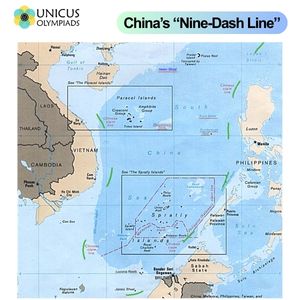

The South China Sea, along with other areas like the Korean Peninsula, the Strait of Hormuz, and Eastern Europe, is considered a global hotspot due to its geopolitical significance, economic importance, and the potential for conflict. A "hotspot" is a region where tensions are high, and there is the risk of violent conflict or escalation due to competing interests from multiple countries, often involving territorial disputes, economic competition, and military posturing. The South China Sea is a particularly crucial hotspot because of the convergence of international maritime interests, strategic military positioning, and ongoing territorial disputes. This article explores why the South China Sea is considered a global hotspot and examines the key issues that contribute to its high-stakes nature.
The South China Sea is one of the most strategically important waterways in the world. It is located between Southeast Asia and the Pacific Ocean, acting as a key maritime trade route that connects some of the world's most economically powerful nations. The geopolitical importance of the region is driven by its role in international trade, energy resources, and military strategy.
The South China Sea is one of the busiest maritime trade routes in the world. Over $3 trillion worth of global trade passes through the South China Sea every year, making it a critical artery for global commerce. The waters connect China, Japan, South Korea, and other East Asian economies with the rest of the world. The flow of goods through this region is vital for the global economy, especially for major economies like the United States and the European Union.
The South China Sea is believed to contain substantial underwater oil and natural gas reserves. Various countries with territorial claims in the region, particularly China, the Philippines, Malaysia, Brunei, and Vietnam, have sought to explore and exploit these resources. These resources have heightened tensions, as the countries involved vie for control over potential energy-rich areas.
The South China Sea is strategically important for military positioning, particularly for China. Control over the region would allow China to exert influence over critical shipping lanes and protect its maritime interests. For the U.S. and its allies in the region, including Japan, Australia, and the Philippines, the South China Sea is a crucial point for maintaining a balance of power and ensuring freedom of navigation in international waters.
The South China Sea is a hotbed of territorial disputes, with several countries claiming sovereignty over various islands, reefs, and maritime areas. These disputes have created an environment of tension and conflict, with the potential for military confrontation. The competing claims in the region involve China, the Philippines, Vietnam, Malaysia, Brunei, and Taiwan.
China’s territorial claims in the South China Sea are based on the so-called “nine-dash line,” which encircles most of the sea. This claim extends far beyond the boundaries established by international maritime law, including areas that are within the exclusive economic zones (EEZ) of other countries like the Philippines and Vietnam. China’s efforts to assert control over these areas have been met with resistance from neighboring countries and have led to clashes over fishing rights, maritime boundaries, and resource exploitation.

The Philippines, Vietnam, Malaysia, Brunei, and Taiwan have all made competing territorial claims in the South China Sea. These countries argue that they have legitimate rights to various islands and maritime zones within the region. The Philippines, in particular, has been at the forefront of challenging China’s claims, both diplomatically and through legal avenues.
The South China Sea is not only a regional hotspot but a global one due to its economic, strategic, and environmental significance. The conflict over the South China Sea has broad implications for international relations, global trade, and the balance of power in the Indo-Pacific region. Below are some of the key global implications of the South China Sea conflict:
The South China Sea is a critical trade route, with approximately one-third of global shipping passing through its waters. Any disruption to the freedom of navigation in the region would have serious consequences for global trade, particularly in terms of the transport of oil, natural gas, and manufactured goods.
The South China Sea conflict is part of broader power struggles in the Indo-Pacific region. Countries such as China, the U.S., and Japan are competing for influence and strategic control, and the outcomes of the South China Sea disputes will shape the future of regional security and power dynamics.
In addition to the geopolitical and economic impacts, the South China Sea conflict has significant environmental consequences. The construction of artificial islands, the militarization of maritime zones, and the disruption of marine ecosystems have all contributed to environmental degradation in the region.
The South China Sea is one of the most complex and strategically significant hotspots in the world today. The competing territorial claims, combined with the region's economic importance and environmental vulnerability, make it a focal point for global attention. While military conflict remains a possibility, diplomatic efforts, international arbitration, and multilateral cooperation are crucial for ensuring peace and stability in the region. The role of global organizations, such as the United Nations and ASEAN, as well as the involvement of major powers like the United States and China, will be key in managing this conflict and preventing further escalation.